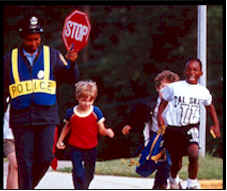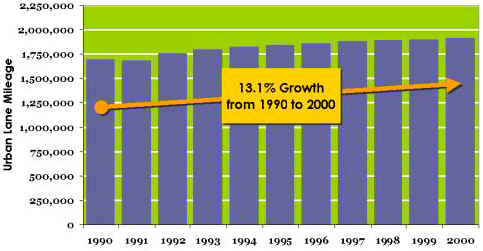
 | |
| ||||||||||||||||||||||||||||||||||||
Library: Decoders | |||
|
Decoding Transportation Policy & Practice # 2 The
Nation’s Road Capacity: Proponents of highway capacity expansion often claim that road building is lagging far behind. The statistic they use to support this argument is that lane miles of roadways have grown by only two percent since 1990. But once we ‘decode’ this figure, it is clear that this is an inaccurate way to assess the capacity of our surface transportation infrastructure.
Where the Roads Are
Where Capacity Is Growing As completion of the Interstate system neared, investment in new roadway capacity to serve built-up areas where the majority of people live and drive has increased. So that while roadway capacity in rural areas has not grown, roadway capacity in metro areas has grown markedly, averaging more than 22,000 additional lane miles each year during the last decade. New numbers from FHWA show that lane miles of roadway in urban areas grew by more than 13 percent from 1990 to 2000. While some of the growth of the urban road network was due to re-classification, new roads and widenings accounted for 69 percent of the total growth.
Finally, it must be noted that rural roads, even with no capacity increase in recent years, are still far from carrying the volumes of traffic they were designed to. On a mile-per-mile basis, rural roads carry only 20 percent as much traffic as urban roads. Even if the number of miles driven on rural roads grew 250 percent, rural roads would carry only half as much traffic on a per-mile basis as urban roads. Transportation planners have not built new roads in rural areas because there is generally no need to increase capacity. But Why Are Our Roads So Congested? This discussion begs the question, given that roadway mileage in urban areas has been growing significantly, why does traffic congestion seem to be so much worse? It has more to do with our growing reliance on driving for daily tasks. For more on this, see Easing the Burden or Why Are the Roads So Congested? on STPP’s website at www.transact.org.
Sources: Federal Highway Administration, Highway Statistics Series, 1990 - 2000. Federal Highway Administration, Census Geography Issues, 2001.
|
 From 1990 to 2000, lane miles of all roadways in
the United States grew by slightly less than 2 (1.8) percent.
From 1990 to 2000, lane miles of all roadways in
the United States grew by slightly less than 2 (1.8) percent. Though most of the population lives in built-up
areas and most driving occurs in these same areas, the vast
majority of roads are in rural areas.
Though most of the population lives in built-up
areas and most driving occurs in these same areas, the vast
majority of roads are in rural areas.